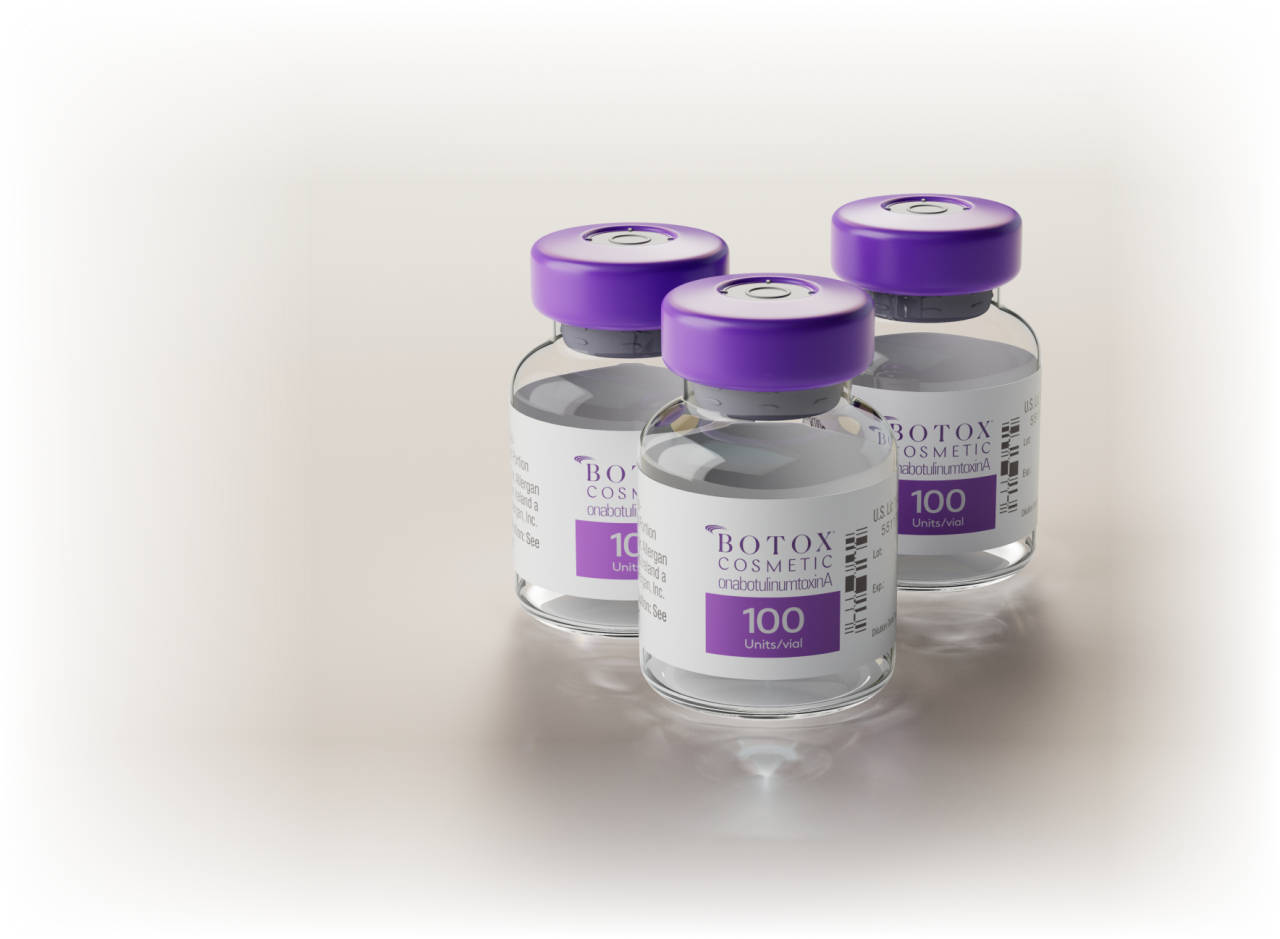The ONE with simultaneous treatment in 3 areas: results from 2 clinical studies1
Two pivotal, multicenter, randomized, double-blind, placebo-controlled studies with 1178 patients
(921 received BOTOX® Cosmetic) treated for moderate to severe forehead lines and glabellar lines or
moderate to severe forehead lines, lateral canthal lines, and glabellar lines simultaneously.1
Predictable results with simultaneous treatment1
Primary end point at day 301:
Composite investigator and patient assessment of forehead line severity at
maximum eyebrow elevation using the 4-point facial wrinkle scale with
photonumeric guide (FWS) at day 30 following the first treatment.1
| Study | BOTOX® Cosmetic (40 Units: 20U FHL + 20U GL) | BOTOX® Cosmetic (64 Units: 20U FHL + 24U LCL + 20U GL) | Placebo | P-Value |
|---|---|---|---|---|
| Study 1 | 61% (178/290) | — | 0% (0/101) | P < .0001 |
| Study 2 | 46% (145/318) | 53% (166/313) | 1% (1/156) | P < .0001 |
FHL = forehead lines; GL = glabellar lines; LCL = lateral canthal lines.
Secondary end point1
Investigator-assessed achievement of none or mild forehead lines from baseline on FWS at maximum
eyebrow elevation (treatment success) in Study 2.1
Results lasted up to 4 months in 3 areas1,2
Patient satisfaction with
simultaneous treatment1,3
Patients in the forehead line trials completed a Facial Line Satisfaction Questionnaire (FLSQ) at day 60 and were asked how satisfied they were with their BOTOX® Cosmetic treatment on a 5-point scale with the following responses: “Very Dissatisfied,” “Mostly Dissatisfied,” “Neither Satisfied or Dissatisfied,” “Mostly Satisfied,” and “Very Satisfied.” The FLSQ is a validated scale.1
Patients are highly satisfied with treatment in 3 areas1,2
BOTOX® Cosmetic patients had higher satisfaction rates over time when treated in 3 areas vs patients treated in 2 areas or with placebo.2,*
*Based on patients in Study 2 who reported being “Very Satisfied” or “Mostly Satisfied” with their treatment in the forehead line trials. In treatment cycle 1, patients were randomized to receive 64 Units of BOTOX® Cosmetic, 40 Units of BOTOX® Cosmetic, or placebo. Responder rates for satisfaction were taken at week 1, week 2, day 30, day 60, day 90, day 120, day 150, and day 180.2
Real patients treated for the appearance of moderate to severe forehead lines, lateral canthal lines, and glabellar lines. Results may vary.
Consistent, repeatable results with simultaneous treatment1,2
The response rate for forehead lines was similar across all 3 treatment cycles1
A total of 165 and 197 patients received 3 cycles of BOTOX® Cosmetic over 1 year: 40 Units (20U FHL + 20U GL) and 64 Units (20U FHL + 24U LCL + 20U GL), respectively.1 Responders were defined as patients achieving ≥ 2-grade composite improvement from baseline on investigator and subject FWS ratings of forehead line severity at maximum eyebrow elevation.
Patient response with repeat treatment in 3 areas1,2
In forehead line clinical trials, all patients were treated in 3 areas with 64 Units in cycles 2
and 3—and with subsequent treatment cycles, results did not return to baseline levels.1,2
Responders Achieving ≥ 2-Grade Composite Improvement From Baseline on Investigator and Subject FWS Ratings of FHL Severity at Maximum Eyebrow Elevation (ITT Population)1,2
Assess each patient for The Look of 3SM—a treatment of 3 areas, with 64 Units, at least 3 times per year.1,†
†Treatments should be spaced at least 90 days apart.1
Adverse reactions seen in clinical studies1
| Reactions | BOTOX® Cosmetic (n = 665) | Placebo (n = 315) |
|---|---|---|
| Headache | 9% (58/665) | 5% (17/315) |
| Eyelid ptosis | 2% (12/665) | 0% (1/315) |
| Brow ptosis | 2% (13/665) | 0% (0/315) |
| Skin tightness | 2% (10/665) | 0% (0/315) |
There were no additional adverse drug reactions reported with the simultaneous treatment of
forehead lines, lateral canthal lines, and glabellar lines.1
Order BOTOX® Cosmetic now
Order Allergan Aesthetics products or manage your account on AllerganDirect.com


Education
Train on reconstitution, assessment strategies, injection techniques, and more.
Results
See the real results of patients treated with BOTOX® Cosmetic.
The Look Of 3SM
Learn about The Look of 3SM —
a treatment of 3 areas, with 64 Units, at least 3 times a year for appropriate patients.1,†
†Treatments should be spaced at least 90 days apart.1
